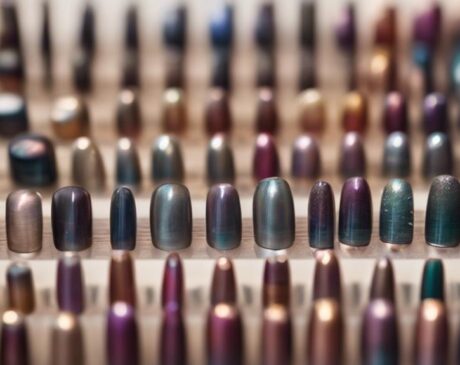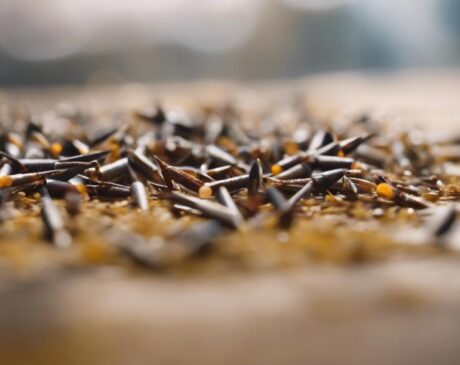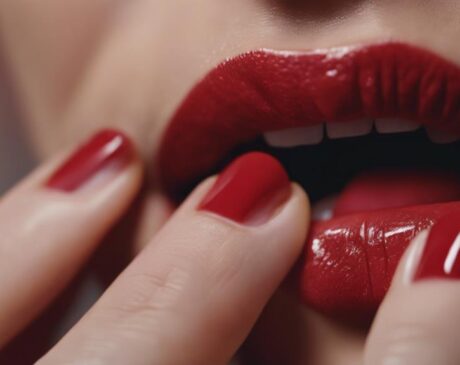Why Is My Black Gel Polish Not Curing?

Insufficient curing time, low-quality products, incorrect application methods, light source issues, excessive thickness, or old polish may cause black gel polish not to cure properly. To ensure a flawless result, consider factors like the curing duration, product quality, application techniques, light source quality, thickness of the layers, and the age of the polish. Each plays a crucial role in achieving a perfectly cured black gel polish. Understanding the nuances of these factors can help troubleshoot and resolve the curing issues effectively.
Key Takeaways
- Ensure proper curing time by extending it slightly for black gel polish.
- Use high-quality LED or UV lamps for thorough curing.
- Opt for reputable gel polish brands to prevent curing issues.
- Apply thin layers and follow recommended cure times strictly.
- Evaluate the light source for wavelength and intensity to improve curing effectiveness.
Inadequate Curing Time

With black gel polish application, ensuring adequate curing time is essential for a flawless and durable finish. Proper curing allows the gel polish to harden and bond to the nail, providing long-lasting wear. Black gel polish, in particular, can be more challenging to cure due to its dark pigment, which absorbs light and heat during the curing process. To overcome this, consider curing each layer of black gel polish for a slightly longer time than lighter colors. Additionally, using a high-quality LED or UV lamp with the correct wattage can help ensure thorough curing.
Innovations in gel polish technology have led to the development of lamps with specific curing modes tailored to different colors and formulas. These specialized lamps emit the ideal light spectrum and intensity to cure black gel polish efficiently. By following manufacturer guidelines on curing times and techniques, you can achieve optimal results with your black gel polish application. Remember, patience during the curing process is key to achieving a flawless and durable finish.
Poor Quality Gel Polish
When dealing with poor quality gel polish, it is crucial to conduct thorough research and carefully select reputable brands known for their high-quality formulations. In the world of nail care, the quality of the products used can significantly impact the final results. Here are some key points to consider when dealing with poor quality gel polish:
- Ingredient Quality: Ensure that the gel polish contains high-quality ingredients that are safe and effective.
- Testing and Reviews: Look for brands that have undergone testing and have positive reviews from professionals and consumers.
- Consistency: Opt for gel polishes that have a consistent texture and application process to ensure a smooth and even finish.
- Durability: Choose gel polishes that are known for their durability and long-lasting properties to maintain your manicure for an extended period.
Incorrect Application Technique

When applying gel polish, it is crucial to ensure that each layer is thin to allow for proper curing. Additionally, adequate cure time under the UV or LED lamp is essential for a durable and long-lasting finish. Failure to follow these steps can result in issues with the gel polish not curing correctly.
Thin Layers
Are your black gel polish layers consistently failing to cure properly, leading to frustration and wasted time? One common reason for this issue could be applying thin layers incorrectly. Thin layers are essential for proper curing of gel polish. Here are some key points to consider:
- Thin, Even Application: Ensure you apply a thin and even layer of black gel polish to allow for thorough curing.
- Avoid Overloading: Do not overload the brush with gel polish, as this can lead to uneven application and curing issues.
- Proper Base Coat: Always start with a suitable base coat to help the gel polish adhere better to the nails.
- Avoid Rushing: Take your time during the application process to ensure each layer is applied correctly for optimal curing results.
Inadequate Cure Time
One critical factor contributing to the inadequate curing of black gel polish could be linked to the application technique, particularly the duration of cure time. When applying black gel polish, it is crucial to adhere strictly to the recommended cure times provided by the manufacturer. Failure to cure the polish for the specified duration can result in a sticky or tacky layer that compromises the overall finish. To ensure proper curing, consider investing in a high-quality LED or UV lamp with adequate wattage. Additionally, always remember to cure each layer evenly and consistently to achieve a flawless result.
| Common Issues | Causes | Solutions |
|---|---|---|
| Inadequate Cure Time | Not curing for the recommended duration | Follow manufacturer's cure time guidelines |
| Uneven Application | Applying gel polish unevenly | Use thin, even coats for each layer |
| Incorrect Lamp Wattage | Inadequate power for curing | Use a lamp with sufficient wattage |
Light Source Issues
Proper evaluation of the light source is crucial to ensuring optimal curing of black gel polish. The light source plays a fundamental role in the polymerization process, and issues with it can lead to incomplete curing, resulting in tacky or soft gel polish.
- Wavelength: Ensure the light source emits the appropriate wavelength for curing black gel polish effectively.
- Intensity: Check that the light source provides sufficient intensity to penetrate the layers of gel polish for thorough curing.
- Age of Bulbs: Regularly replace bulbs as they lose intensity over time, affecting the curing process.
- Placement: Position your nails correctly under the light source to ensure uniform exposure and curing of the gel polish.
Gel Polish Too Thick

When encountering gel polish that is excessively thick, it is essential to address this issue promptly to ensure proper curing and a flawless finish. Gel polish that is too thick can lead to uneven curing, resulting in a sticky or tacky layer on the nails. To remedy this, consider thinning out the gel polish using a gel polish thinner. Thinning the polish will improve its consistency, making it easier to apply and ensuring a more even cure under the UV or LED lamp.
Moreover, using a high-quality gel polish that is formulated to the right viscosity can also help prevent the issue of thickness. Look for gel polishes that are specifically designed to provide a smooth and consistent application without being overly thick. Additionally, ensuring that each layer of gel polish is applied thinly and evenly can help prevent excess thickness and promote proper curing.
Gel Polish Too Old
Over time, gel polish may deteriorate and become less effective, posing challenges in achieving a durable and long-lasting manicure. As gel polish ages, the chemical composition can change, leading to issues with curing and adhesion. To address the problem of gel polish being too old, consider the following:
- Storage Conditions: Ensure gel polish is stored in a cool, dark place away from direct sunlight and heat sources to prevent premature aging.
- Expiration Dates: Check the expiration date on the gel polish bottle and dispose of any expired products to maintain quality.
- Shake Well: Before use, shake the bottle well to mix any separated components and ensure uniform consistency for proper curing.
- Quality Check: Perform a small test patch on a nail or a swatch to assess the curing efficiency of the gel polish before applying it to the entire nail surface.
Frequently Asked Questions
Can Using a Different Brand of Gel Polish Affect the Curing Time?
Yes, using a different brand of gel polish can affect curing time due to variations in formulation and compatibility with the curing lamp. It is recommended to follow the specific instructions provided by the gel polish manufacturer for optimal results.
How Can I Tell if My Gel Polish Is Poor Quality?
The quality of gel polish can be discerned through factors like consistency, opacity, and ease of application. Look for reputable brands known for their durability and performance. Inferior products may exhibit uneven coverage or premature chipping.
Are There Any Specific Techniques I Should Avoid When Applying Gel Polish?
When applying gel polish, avoid thick layers, overworking the product, and improper curing techniques. Opt for thin, even coats, proper curing times, and avoiding excessive heat or light exposure. Following these techniques can improve the longevity and quality of your gel polish application.
What Are Some Common Issues With Different Types of Light Sources for Curing Gel Polish?
Utilizing a variety of light sources for gel polish curing can lead to diverse challenges, such as insufficient wavelengths or inadequate power output. Innovation in light technology is crucial for addressing these issues effectively and ensuring flawless outcomes.
How Can I Thin Out Gel Polish That Is Too Thick?
To thin out gel polish that is too thick, carefully add a few drops of gel polish thinner. Gently mix the product until you achieve the desired consistency. Avoid adding too much thinner to prevent altering the polish's performance.




